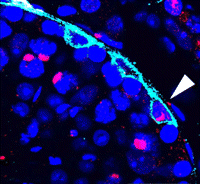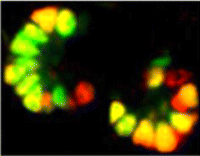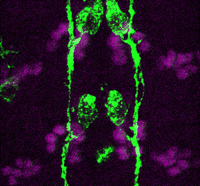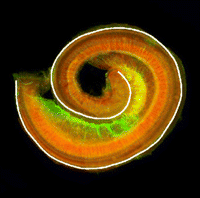Interview with Beddington Medal winner Boyan Bonev
Posted by Eva Amsen, on 27 April 2012
 Each year, the British Society for Developmental Biology awards the Beddington Medal for the best PhD thesis in developmental biology. At the 2012 BSDB meeting, this award went to Boyan Bonev, who completed his PhD in Nancy Papalopulu’s lab at the University of Manchester. At the conference, Boyan gave a talk about his PhD work, describing how microRNA-9 promotes neural progenitor heterogeneity in a context-dependent manner. Find out more about Boyan’s work, and what he’s up to next, in this interview.
Each year, the British Society for Developmental Biology awards the Beddington Medal for the best PhD thesis in developmental biology. At the 2012 BSDB meeting, this award went to Boyan Bonev, who completed his PhD in Nancy Papalopulu’s lab at the University of Manchester. At the conference, Boyan gave a talk about his PhD work, describing how microRNA-9 promotes neural progenitor heterogeneity in a context-dependent manner. Find out more about Boyan’s work, and what he’s up to next, in this interview.
What was your thesis about?
My graduate work was about the role of the microRNA miR-9 in neural development. MicroRNAs are a really exciting part of the genome, because they’re small, non-coding RNAs. They were discovered about ten years ago, and since then there’s been a tremendous amount of research carried out to find out what exactly their role is. There are many occasions where microRNAs have an essential role, particularly during development. What I wanted to find out is how miR-9 regulates neural development, in particular in vertebrates. MiR-9 has a really interesting expression pattern: the microRNA is present in the brain, but expressed differently in different parts of the brain. So, the really cool thing about miR-9 is that it turned out to have a context-dependent function, and this is really the key highlight of my thesis. It means that in some parts of the brain miR-9 does one thing, and in other parts it does something else. During development it also changes its function. For example, in my talk I talked about progenitor heterogeneity, and how miR-9 can regulate this, but we also looked at its function in mature neurons, where it does something else entirely, which is to modulate axon branching and axon extension. It’s really cool how nature seems to be using one molecular mechanism in a different way, depending on where you look along the anterior-posterior axis, or at which developmental stage the organism is, to get feedback about what decisions the cells need to make.
You showed work in both frog and mouse. Which one do you prefer to work with?
To be honest I find working with both of them really exciting. Working with frogs is a little bit easier, because they develop externally, so it’s easier to get sufficient numbers and it’s easier to manipulate them from the very beginning. They’re a really good model organism for studying early developmental events in particular. However, to work on something that is more closely related to the human brain, which is ideally what we want to understand, mouse is the better system. That’s why I started to work more and more on mouse, especially in the last part of my PhD. Other than that they’re both really nice organisms to work with.
In your talk you described how a microRNA target in turn regulates the microRNA. Is that a common mechanism?
There are not that many instances where such negative feedback regulation is known, but I think it’s becoming more and more prevalent that this is indeed a very interesting type of regulation. Not just for microRNAs, but also in the case of transcription factors with negative feedback loops. I think what is really important to consider is that these transcription factors and microRNAs do not work in isolation – they all work together with all their partners. And these kind of feedback loops, whether they are coherent or incoherent feedback loops, are the ones that buffer against developmental noise or reinforce a decision. In our case this was a negative feedback loop that was doing both, because it was promoting oscillations, but it was also reinforcing developmental decisions.
What are you doing now?
I was supposed to have a bit of a long break between my PhD and before I started my postdoc, but it boiled down to about ten days in the end. Right now I’m going back to my home country, Bulgaria, to have the rest of the ten days off. At the end of the month I’m leaving for the States to start working on my postdoc.
What will you be doing in your postdoc?
That’s going to be another cool and exciting project. It’s also related to non-coding RNAs and neural development, but it’s completely different from what I’ve been doing so far. It focuses on a different, newer, type of non-coding RNAs: long non-coding RNAs. I told you that microRNAs are about ten years old – well, these long ncRNAs are about 3-4 years old.
I’m going to Harvard, where I will be working in the lab of John Rinn, who is one of the guys who discovered long ncRNAs, and in Paula Arlotta’s lab, who is an expert in mouse neural development, in particular mouse cortical development. I’m going to be working with both of them to try to figure out the function of long ncRNAs in mouse neural development.
Do you have any advice for new PhD students?
Be persistent. At some point, things will probably stop working, and you’re going to be struggling to figure out why they’re not working. What I always say is that the result is the result. Your inability to figure out why it is like that is the problem. But usually things like technical difficulties or problems with the model organism have a meaning, and you have to be persistent and really go down to the details to figure out what’s going on.
![]() Bonev, B., Pisco, A., & Papalopulu, N. (2011). MicroRNA-9 Reveals Regional Diversity of Neural Progenitors along the Anterior-Posterior Axis Developmental Cell, 20 (1), 19-32 DOI: 10.1016/j.devcel.2010.11.018
Bonev, B., Pisco, A., & Papalopulu, N. (2011). MicroRNA-9 Reveals Regional Diversity of Neural Progenitors along the Anterior-Posterior Axis Developmental Cell, 20 (1), 19-32 DOI: 10.1016/j.devcel.2010.11.018
Dajas-Bailador, F., Bonev, B., Garcez, P., Stanley, P., Guillemot, F., & Papalopulu, N. (2012). microRNA-9 regulates axon extension and branching by targeting Map1b in mouse cortical neurons Nature Neuroscience, 15 (5), 697-699 DOI: 10.1038/nn.3082


 (5 votes)
(5 votes) (No Ratings Yet)
(No Ratings Yet) Registration deadlines:
Registration deadlines: (4 votes)
(4 votes) During development and homeostasis, it is essential to coordinate growth with the availability of nutrients. The interconnected insulin/IGF (IIS) and target of rapamycin (TOR) pathways integrate tissue growth with dietary conditions in Drosophila, and now Marc Haenlin and co-workers show that these pathways play a crucial role during haematopoiesis in the Drosophila lymph gland (
During development and homeostasis, it is essential to coordinate growth with the availability of nutrients. The interconnected insulin/IGF (IIS) and target of rapamycin (TOR) pathways integrate tissue growth with dietary conditions in Drosophila, and now Marc Haenlin and co-workers show that these pathways play a crucial role during haematopoiesis in the Drosophila lymph gland ( Spermatogonial stem cells (SSCs) have the remarkable ability to self-renew and support spermatogenesis throughout life. It is known that fibroblast growth factor 2 (FGF2) promotes SSC self-renewal but the factors acting downstream of FGF2 are unknown. Here, Takashi Shinohara and colleagues show that FGF2 regulates SSC self-renewal via MAP2K1 and the Etv5 and Bcl6b genes (
Spermatogonial stem cells (SSCs) have the remarkable ability to self-renew and support spermatogenesis throughout life. It is known that fibroblast growth factor 2 (FGF2) promotes SSC self-renewal but the factors acting downstream of FGF2 are unknown. Here, Takashi Shinohara and colleagues show that FGF2 regulates SSC self-renewal via MAP2K1 and the Etv5 and Bcl6b genes ( In the developing pancreas, the branched epithelium can be separated into tip and trunk regions, with the tip domain generating acinar cells, and the trunk domain differentiating to endocrine and duct fates. Although Notch signalling is known to be important for proper pancreatic development, particularly in maintaining the progenitor state and inhibiting premature endocrine differentiation, its precise roles in regulating cell fate remain unclear. Here (
In the developing pancreas, the branched epithelium can be separated into tip and trunk regions, with the tip domain generating acinar cells, and the trunk domain differentiating to endocrine and duct fates. Although Notch signalling is known to be important for proper pancreatic development, particularly in maintaining the progenitor state and inhibiting premature endocrine differentiation, its precise roles in regulating cell fate remain unclear. Here ( Accurate axonal pathfinding relies on the tightly regulated expression of guidance cues and their receptors, but the links between transcriptional regulators and downstream guidance factors are poorly understood. Genetically amenable Drosophila motoneurons provide an ideal system for analysing the control of guidance receptor expression. It is known that two transcription factors, Even-skipped (Eve) and Grain (Grn) are expressed in the aCC and RP2 motoneurons, and that projection of these neurons to the muscle requires the Netrin receptor Unc-5. Now, Juan-Pablo Labrador and colleagues dissect out the relationships between these factors (
Accurate axonal pathfinding relies on the tightly regulated expression of guidance cues and their receptors, but the links between transcriptional regulators and downstream guidance factors are poorly understood. Genetically amenable Drosophila motoneurons provide an ideal system for analysing the control of guidance receptor expression. It is known that two transcription factors, Even-skipped (Eve) and Grain (Grn) are expressed in the aCC and RP2 motoneurons, and that projection of these neurons to the muscle requires the Netrin receptor Unc-5. Now, Juan-Pablo Labrador and colleagues dissect out the relationships between these factors ( The atypical cadherin Fat (Ft) is crucial for planar cell polarity (PCP) in Drosophila. Four ft homologs (Fat1 to Fat4) have been identified in mammals, but the functional roles of these homologs and any possible redundancies between them are unclear. Here, Helen McNeill and colleagues study the genetic interactions between mammalian Fat genes and show that Fat proteins act both synergistically and antagonistically to regulate multiple aspects of tissue morphogenesis in mice (
The atypical cadherin Fat (Ft) is crucial for planar cell polarity (PCP) in Drosophila. Four ft homologs (Fat1 to Fat4) have been identified in mammals, but the functional roles of these homologs and any possible redundancies between them are unclear. Here, Helen McNeill and colleagues study the genetic interactions between mammalian Fat genes and show that Fat proteins act both synergistically and antagonistically to regulate multiple aspects of tissue morphogenesis in mice ( The kidney comprises multiple cell types of both epithelial and mesenchymal origin, with highly defined regional subdivisions in the ductal systems. A full understanding of kidney development requires that each cell type can be uniquely identified by specific molecular markers. To this end, Andrew McMahon and colleagues have undertaken a comprehensive analysis of the RNA expression patterns of nearly one-thousand transcription factors in the embryonic mouse kidney (
The kidney comprises multiple cell types of both epithelial and mesenchymal origin, with highly defined regional subdivisions in the ductal systems. A full understanding of kidney development requires that each cell type can be uniquely identified by specific molecular markers. To this end, Andrew McMahon and colleagues have undertaken a comprehensive analysis of the RNA expression patterns of nearly one-thousand transcription factors in the embryonic mouse kidney (